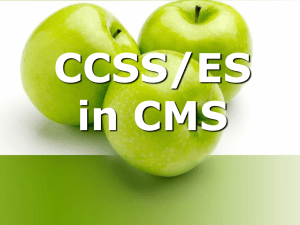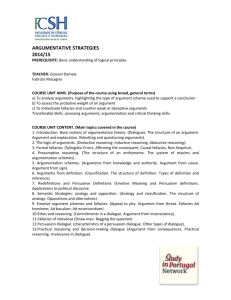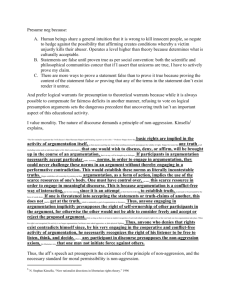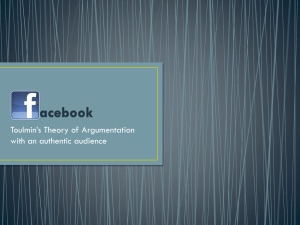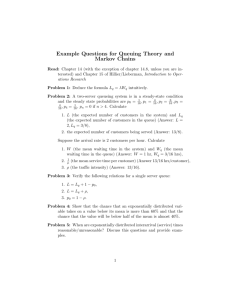A Dialectic Architecture for Computational Autonomy
advertisement
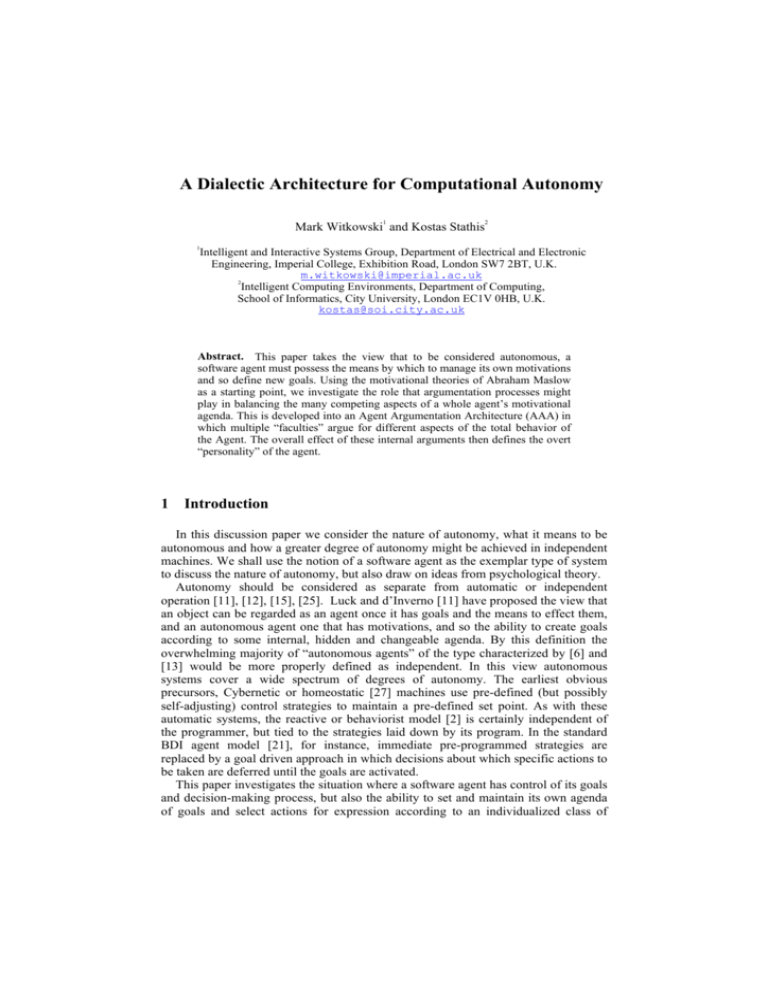
A Dialectic Architecture for Computational Autonomy
1
2
Mark Witkowski and Kostas Stathis
1
Intelligent and Interactive Systems Group, Department of Electrical and Electronic
Engineering, Imperial College, Exhibition Road, London SW7 2BT, U.K.
m.witkowski@imperial.ac.uk
2
Intelligent Computing Environments, Department of Computing,
School of Informatics, City University, London EC1V 0HB, U.K.
kostas@soi.city.ac.uk
Abstract. This paper takes the view that to be considered autonomous, a
software agent must possess the means by which to manage its own motivations
and so define new goals. Using the motivational theories of Abraham Maslow
as a starting point, we investigate the role that argumentation processes might
play in balancing the many competing aspects of a whole agent’s motivational
agenda. This is developed into an Agent Argumentation Architecture (AAA) in
which multiple “faculties” argue for different aspects of the total behavior of
the Agent. The overall effect of these internal arguments then defines the overt
“personality” of the agent.
1
Introduction
In this discussion paper we consider the nature of autonomy, what it means to be
autonomous and how a greater degree of autonomy might be achieved in independent
machines. We shall use the notion of a software agent as the exemplar type of system
to discuss the nature of autonomy, but also draw on ideas from psychological theory.
Autonomy should be considered as separate from automatic or independent
operation [11], [12], [15], [25]. Luck and d’Inverno [11] have proposed the view that
an object can be regarded as an agent once it has goals and the means to effect them,
and an autonomous agent one that has motivations, and so the ability to create goals
according to some internal, hidden and changeable agenda. By this definition the
overwhelming majority of “autonomous agents” of the type characterized by [6] and
[13] would be more properly defined as independent. In this view autonomous
systems cover a wide spectrum of degrees of autonomy. The earliest obvious
precursors, Cybernetic or homeostatic [27] machines use pre-defined (but possibly
self-adjusting) control strategies to maintain a pre-defined set point. As with these
automatic systems, the reactive or behaviorist model [2] is certainly independent of
the programmer, but tied to the strategies laid down by its program. In the standard
BDI agent model [21], for instance, immediate pre-programmed strategies are
replaced by a goal driven approach in which decisions about which specific actions to
be taken are deferred until the goals are activated.
This paper investigates the situation where a software agent has control of its goals
and decision-making process, but also the ability to set and maintain its own agenda
of goals and select actions for expression according to an individualized class of
arguments and internal priorities. Full autonomy and thus complete freedom from the
programmer requires that the agent can learn new activities, adopt new goals and, for
complete autonomy, devise new learning strategies also.
The term “autonomy” is derived from the ancient Greek Αυτονοµια, meaning
self-regulation by having self-laws. Formal models of Deontics, the formalization of
duties, obligations and prohibitions, seem counterproductive in this context. At their
heart, the paradox of the notion of something that is obligatory, yet coupled to
sanction to be applied if that obligation is not fulfilled (“contrary to duty”). Note that
this paper is not a discussion of morality, of rights and wrongs, but rather of
mechanism. A fully autonomous agent cannot be obliged (as in deontics) to conform
to law, but must decide the consequences under its own prioritization and proceed or
not (e.g. without sanction, law has no effect). An agent need not be isolated from
other agents, it will need to interact and cooperate with peers. Furthermore, an agent
does not need to act as a servant, but might elect to act as such.
We are interested in producing a generic architecture, building on notions proposed
by Kakas and Moraïtis [8], for embodied and non-embodied entities to achieve full
autonomy for its own sake. But we will then consider implications for practical
technology, which may in turn tell us something about the human condition. Why, for
instance, do we consider ourselves autonomous? Having made the proposal for such
an architecture in the body of this position paper, we return in the discussion section
to these issues. The issues under discussion here are at the edge of what current
techniques in reasoning can be expected to achieve, and are perhaps at the very
boundary of what logic can be expected to represent, at least in its current form ([9]
for a discussion). Detailed considerations of the logic formalization fall outside the
scope of this position paper.
Section two presents a view of the motivational theories [14] of Abraham Maslow
(1908-1970), and asks whether they can offer any insight into how a software agent
may be made more completely autonomous. A software agent might do so by taking
more immediate control of its own behavioral agenda, setting its own goals and
determining the overall outcomes and consequences to the agent in terms of those
various and varying motivating factors. We shall use the approach laid out by Maslow
as a starting point, but argue that its provisions do not entirely apply in the case of
Software Agents.
Section three we will look at extensions to the last class of autonomous agents,
loosely based on notions of the BDI architecture ([1], [21]), in which processes
(“faculties”) encapsulating a number of different top-level goals (which appear as
“motivations” to an observer of the agent, or to the introspective agent) must both
propose new actions or goals that support the area they are responsible for, and argue
that these goals should be adopted by the agent as a whole. We shall take the view
this overall process can and should be viewed and modeled as one of a dialectic
argumentation game, in which individual faculties must both argue for the value of
their individual contribution, of which they are a part.
Argumentation has found favor recently as a way of modeling legal arguments
using logic ([10], [19], and [20] for review). We note that there are significant
differences between legal and internal argumentation, and that the categories of
argument must therefore be different. Section five will discuss a procedural layer,
providing for a game-like protocol by which the argumentation might take place.
2
Personality and Motivations
This section takes as its starting point a discussion of the motivational theories of
Maslow [14]. Maslow’s work has been influential in the understanding of human
drive and its relationship to the expression of personality (and thence to our notions of
autonomy as individuals). It is important because it attempts to relate a model of
underlying processes to observable traits, and as such stands apart from work which
primarily serves to categorize and measure personality (e.g. [5], [7], and [22] for
review).
Maslow describes five classes of motivation, forming a dynamic “needs
hierarchy”. At the base level are Physiological needs, the immediate requirements to
maintain the function of the organism. These needs, in the living organism, will
include homeostatic [27] functions, such as blood sugar or oxygen balance, or
hydration levels. Physiological needs may also drive complex behaviors, such as food
acquisition, that are not well modeled with a control theoretic approach. At the next
level Safety Needs predominate. In this respect Maslow specifically refers to the
search for stability and freedom from fear and anxiety in the individual’s continuing
context, rather than freedom from immediate danger. At the third level Belongingness
and Love Needs emerge. These refer to the apparent human requirement to seek out
and maintain immediate contact with other individuals in a caring and cared for
context (“the giving and receiving of affection”). Maslow argues that failure to
achieve or denial of these needs leads to a wide range of distressing psychological
symptoms. At the fourth level Esteem Needs emerge. Maslow divides these needs
into two primary categories, the need for self-esteem, “… the desire for strength,
achievement … independence and freedom” and for the esteem of others, “… status,
fame and glory, dominance, recognition, attention, importance, dignity, or
appreciation”. It is clear that these two categories (as with the other major needs)
cover a broad spectrum of possible drivers for activity. At the final level Selfactualization Needs, the individual is driven to develop its capabilities to the highest
degree possible, “what humans can be, they must be”. This level will include
invention and aesthetic (musical, artistic, and, presumably, scientific) achievement.
In describing this as a needs hierarchy, Maslow postulates that until a lower level
need is satisfied, the next level will not emerge. We suggest that this does not
represent a true hierarchy (in the sense that one level facilitates, or is facilitated by,
the next), rather that the lower, say physiological needs, are just generally more
urgent than the others, so the argument for satisfying them becomes correspondingly
stronger and not easily overturned by less urgent topics. Such a mechanism still
appears to the observer as a “hierarchy” in the manner indicated by Maslow. Yet it is
clear that, in humans at least, the higher-level “needs” can completely subsume the
lower. An artist might starve in his garret to produce works of great personal
aestheticism, which nobody else appreciates. An ambitious person might seek public
esteem at the expense of personal relationships and happiness – yet still be a glutton.
Kakas and Moraïtis [8] describe the power structure between the basic Maslow
levels (motivations Mi and Mj, for instance) using a priority relation (h_p(Mi,Mj))
indicating that Mi has a higher priority than Mj. Morignot and Hayes-Roth [17]
suggest a weighting vector to arbitrate between levels. These schemes have a gross
effect on “personality”. The levels appear to have, and need to have, a more subtle
interaction, sometimes winning out, sometimes losing.
Maslow elegantly captures this idea: “sound motivational theory should … assume
that motivation is constant, never ending, fluctuating, and complex, and that this is an
almost universal characteristic of practically every … state of affairs.” The model we
propose divides the agent’s reasoning into many independent but interacting faculties.
Each faculty is responsible for arguing the case for the activity or approach for which
it is responsible and any that support it, and arguing against any that would contradict
it. The strength of each faculty is determined primarily by the number and
applicability of arguments it has available, but ultimately on notions of implicit
preference which definitively answers the question “what is it that I want more?”
Maslow argues that there is no value in trying to enumerate a fixed list of drives
(despite producing long lists of need descriptive adjectives to illustrate his levels), and
that drives overlap and interact. Yet to produce an equivalent “motivation theory” for
a software agent, we must exactly isolate the specific factors that will motivate the
behavior of the individual agent and produce some form of explanation as to why they
should be incorporated into the design in addition to proposing a mechanism by which
they might appear as “never ending, fluctuating, and complex”.
In this part of the paper we consider a partial equivalence between the human
interpretations of the Maslow motivations to that of a software agent. Agent faculties
can be divided into several main grouping. (1) Operational: those relating to the
immediate protection of the agent and its continuing operation. (2) Self-benefit:
Those relating to aspects of the agent’s behavior that is directly related to its ongoing
protection and individual benefit. (3) Peer-interaction: those relating to individually
identified entities, human or artificial, with which it has specific relationships. (4)
Community-interaction: those relating to the agent’s place in an electronic society
that might contain both other software agents and humans, with which it must
interact. This category might include both informal and institutionalized groups. (5)
Non-utilitarian: longer-term activities, not directly related to tasks that offer an
immediate or readily quantified benefit.
We assume that the key resource that a software agent must maintain is access to
processor cycles, associated data storage and the communications medium reflecting
the immediate protection criteria (1). Without immediate access to an active host the
agent is completely ineffective and effectively dead. The situation is somewhat more
apparent with an embodied agent, such as a robot, where access to uninterrupted
power and avoidance of physical damage are clear criteria [17].
Category (2) above equates broadly to the safety needs. In this category an ecommerce agent might seek to accumulate financial strength to pay for a reliable
infrastructure strategy, or construct a viable migration plan.
Category (3) addresses how to interact with immediate, individually identified
humans and other software agents. Each will have its own personality, and the agent
must tailor its interactions with them in specific ways to maintain appropriate
relationships and be able to achieve its goals in the future. This broadly equates to the
care and kinship needs, though it may be that an autonomous agent might take a
hostile view towards a third party, perhaps arguing that “my friend’s enemy is my
enemy”. That is, the relationship between an established ally is more important than
the third party, and that it would be jeopardized by perceived collaboration with that
third party. An alternative, more social, view would propose the agent has a duty of
care towards them anyway. How an autonomous agent would represent or express a
personal dislike remains to be explored.
In category (4) the agent accumulates arguments relating to the peer groups,
identified, but not individualized and towards the greater society in which it, and any
human partner with which it is associated must operate. In the case of an e-commerce
assistant agent, this will almost certainly include aspects of the full legal system, and
would certainly include the norms and standards of the particular trading circles in
which the agent and partner choose to operate.
Level (5) remains problematic for software agents in the absence of a “feel-good”
qualia for agents, but one might speculate that successful agents, those that have
accumulated an excess of resources by careful management or good luck would have
the opportunity to continue exploring their world for self-improvement alone. One
could speculate even further that some might continue to accumulate excess resources
for its own sake, or enter into philanthropic activities for less-fortunate agents or
agent communities of their choosing.
3
A Game-based Architecture for Dialectic Argumentation
The Agent Argumentation Architecture (AAA), shown in Figure 1, consists of the
following components, an Argumentation State, a Knowledge Base (KB), a number
of Faculties (F), an “attender” module (managing the flow of incoming information)
and a “Planner/Effector” module (responsible for making plans from goals and
performing actions as required). The interaction between components is organized as
a complex game consisting of argument sub-games for achieving goals. We draw
from the representation already available in [23] to describe games of this kind in
terms of the valid moves, their effects, and conditions for when these argument subgames terminate and when goals may be reestablished.
The Argumentation State (AS): A communal structure for the current state of the
game, including the arguments put forward, and not yet defeated or subsumed, but
accessible by the faculties and the input and output modules.
The Knowledge Base (KB): Acts, conventionally, as a long-term repository of
assertions within the system. For the purpose of the discussion that follows we shall
assume that the elements held in KB take the form of conjectures, rather than
expressions of fact. To assume this implies that the knowledge of the agent is nonmonotonic, credulous (as opposed to skeptical), and allows inconsistency. On the
other hand, a monotonic, skeptical and consistent knowledge base hardly allows for
an argumentation process, as it is always obliged to agree with itself.
We will partition the KB according to the Maslow motivation types (KB = {Km1 ∪
Km2 ∪ Km3 ∪ Km4 ∪ Km5}, as indicated by the solid radial line in figure 1) and
according to the faculties (KB = {Kf1 ∪ … ∪ Kfn}, as indicated by the dotted radial
lines in figure 1). We assume that the number of faculties (n) will be greater than 5,
and that some faculties will impinge on more than one motivational category.
Km2
Km3
Knowledge Base (K)
Kf3
Kf2
f3
f4
f5
f2
Km1
f1
Argumentation
State
Kf5
Km4
fn
Kfn
Kf1
More
Urgent (Ku)
Kf4
Attender
Planner/
Dispatcher
Km5
Less
Urgent (Ku)
Figure 1: The Agent Argumentation Architecture (AAA)
The Faculties: Faculties (F = {f1 … fn}) are responsible for particular aspects of
the whole agent’s possible agenda, which taken together will comprise every aspect
that the agent can address. Each faculty may therefore argue that a goal should be
established to actively achieve some aspect of that agenda (or avoid some situation
that would be detrimental to the agenda). Equally it must monitor the goals and
actions proposed by other faculties to determine whether the consequences of those
goals or actions would interfere with or contradict some aspect of its own agenda. If
some proposal supports the faculty’s agenda, it will argue in support of the proposal,
or argue against it if the agenda is contradicted. A faculty could, of course be
ambivalent towards a proposal, which can have both positive and negative
consequences, the faculty being supportive, unsupportive or neutral according to the
relative merits of the two positions. Each faculty is arguing the whole agent’s best
interests are served by pursuing (or not pursuing) certain courses of action, but from
its specific viewpoint. There is no winner or loser; each faculty is (or at least, should
be) working towards the overall advantage of the whole agent. Essentially each
faculty has an “opinion” of what is best for the agent as a whole, but from its limited
viewpoint, and must successfully argue its case against other possibly competing
views for this to prevail and become incorporated into the agent’s overt behavior.
The “Planner/Effector” module: Is responsible for creating prototype plans from
agreed goals and effecting actions from agreed plans.
The “Attender” module: We assume that there is a continuous stream of
incoming information, which will comprise of at least the following types of item:
requests to perform activities on behalf of other agents, broad suggestions of things
the agent might like to do or adopt (for instance, adverts, suggestions by providers
that the recipient would be advantaged by purchasing or doing something), “news”
items, indicating the outcome of various previous actions and activities, and solicited
or unsolicited assertions from other agents, which the current agent may or may not
wish to adopt according to its current motivational strategy. These are delivered to the
AS and discarded soon, each faculty having a brief time to inspect and adopt them
into the KB if required.
4
The Role of Argumentation
In this section we consider how argumentation, [10], [19], [20] might play a role in
the architecture for a fully autonomous agent described in the last section. The
majority of work in argumentation has been conducted as an approach to the
mechanization of the legal process, (often) seeking to model how lawyers conduct
cases. In Prakken and Sartor’s view [20] a (legal) argumentation system will have
four notional layers, a logical layer defining the structure of arguments and the
underlying semantics, a dialectical layer defining how conflicting arguments will be
resolved, a procedural layer defining the discourse rules for the argumentation and a
strategic or heuristic layer providing rational ways to conduct the argumentation.
Much attention falls onto the second of these, as it captures the form of the
argumentation process. As legal argumentation is primarily combative it is often
considered as an n-ply game in which one party presents an assertion, which the other
party then attempts to overturn, leading in turn to the possibility of a
counterargument, and so on. The procedure terminates when there is no further
effective counterargument to be made and the argument is therefore won or lost.
Legal argumentation is, in the English and US tradition, both combative and
largely retrospective, comprising accusations and rebuttals between prosecution and
defense. In the legal process there is an overall and external framework to arbitrate
between the parties (the statutes) and sanctions to be applied to those found guilty. In
the proposed model for autonomy, the argumentation will be about current or future
events, goals and actions, and the consequences that may follow if one route or
another is taken. There will be no overall guiding external principle against which a
definitive decision about what to adopt as the overt behavior of the agent might be
judged. Existing models of legal argumentation [20] rely on four major types of
argumentation strategy (though not necessarily all in the same system): Conflicts,
arguments reaching differing conclusions may be rebutted, where one aspect of an
established argument is shown not to hold in the current circumstances, assumption
attack, the assumption of non-provability is presented with a proof, and undercutting,
where one argument challenges the rule of inference used by another. Argument
comparison, where lines of argument are decided by recourse to a higher principle.
Argument status, where defeated arguments may be reinstated if the rebuttal is itself
defeated. In defeasible argumentation, general rules may be defeated by more
specific ones, where a defined priority relationship exists.
The agent argumentation system is driven by the search for, and resolution of
conflicts. Conflicts arise where two faculties arrive at different conclusions at the end
of individual chains of consequences, or one asserts that an action by the other will be
detrimental to its agenda. We identify six classes of argument appropriate to the
AAA:
Goal Proposal Move: Some faculty fn determines that prevailing circumstances
imply that a goal must be asserted or will become asserted shortly.
Conflict of Interests Moves: For a goal or action proposed by faculty fn with
intended consequence x, faculty fm asserts that some y, which it believes is also
consequential leads to a conflict, either by asserting an action that fm determines as
detrimental (interest conflict) or interfering with a current plan of fm (resource
conflict). fn may retract, propose an alternative or a covering action.
Alternative Argument Move: Faculty fm, having detected a conflict of interests,
proposes an alternative solution to achieve fn’s original goal in a manner that does not
conflict with its agenda (cooperative).
Retraction Move: Faculty fn retracts a proposed action or goal, because it is no
longer applicable to fn because of changed circumstances (including conflict with
another faculty).
Undercut Move: Faculty fn challenges the assertion that there is a conflict, and
attempts to undercut fm’s consequence chain, by arguing fm has included an invalid
step or overestimated its significance.
Covering-action Move: Some action a has a positive outcome for fn, but gives rise
to a potential liability according to fm, fm may propose a prior action that would avoid
the liability. This is a “duty of care” argument, complicating the behavior of the agent
to ameliorate possible (but not certain) negative outcome. This argument is
particularly valuable where the undesirable consequence is rare, but highly damaging.
In this model, the agent is required under normal circumstances to completely
exhaust the argumentation process, i.e. to explore all the rational routes to a decision
[1]. A hung decision would, in an isolated system, represent a considerable dilemma
with the agent unable to act. In a connected system, new information is always
arriving on the AS, and this new information may be sufficient to tip the balance one
way or the other. This is, perhaps, the ideal, but likely the agent cannot wait.
Underlying much of human decision-making would appear to be a complex web of
preferences, allowing us to choose between the otherwise rationally un-decidable
alternatives. In the first instance the system should determine whether there are any
preference relations specific to the two items in conflict (prefer(x,y)). The preference
for a rule may be tied closely to the confidence an agent has in it [28]. This being so
the situation is resolved. Failing that, more general classes of preference should be
invoked.
The agent will have a current preference ordering relationship between, say, the
urgency ‘U’ of rules in the knowledge (kn ⊂ K) base. For example the preference
ordering of U (Up) indicates the agent’s current rank ordering of K (k1 .. kn), expressed
as: Up: prefer(u(k34), u(k12), u(k100) …, u(km)). Similarly the agent can place a rank
ordering on the roles of different faculties (Fp: prefer(fn, fq, …, fm)), or on different
motivational areas (Mp: prefer(m2, m1, m3, m4, m5), as in [8]). The agent may further
make explicit the rank ordering of these classes of rankings (e.g. prefer(Up, Fp, Mp)),
and so be in a position to change them. It is clear that, in humans at least, these
preference orderings are quite variable, modified by mood, emotion and recent events.
The outcome of the argumentation process equates to Von Wright’s [26] notion of
an extrinsic preference, subject to reason and rationality, and the rank ordering to
intrinsic preference, hidden and apparently outside rationality. The manner in which
preferences might be dynamically updated, while interesting and perhaps central to
notions of full autonomy, falls outside the scope of this paper.
5
The Procedure
This section outlines the activities (the procedural layer) by which an agent’s
faculties might interact to define a goal directed strategy. Overall, the activities are
essentially asynchronous, with faculties responding to items appearing on the AS, and
are bounded by the computational resource available to them and the whole agent.
Activity 1) Each faculty is responsible for proposing immediate actions or goals
onto the communal AS. It is expected that a goal or action will be one that maintains
or enhances the whole agent, but strictly from the viewpoint of the topic related to the
proposing faculty (i.e. they are expected to be topic “selfish”). This is the primary
creative component of the whole agent. Proposals can be immediate, short or long
term. In general, the lower numbered “motivations” will give rise to immediate and
short-term proposals, the higher numbered ones mid to long-term proposals, reflecting
the scale of urgency. Proposals for immediate actions will often relate to safety or
highly opportunistic situations (a purely reactive faculty could only propose actions).
In an agent of any sophistication there will be many specific goals, of varying
duration, active at any one time. In general, an agent will have many more
suggestions for actions and goals than it could reasonably service. Proposals are
therefore opportunistic and made with the likelihood that they will be rejected. Any
action or goal proposed at this stage represents a “desire” on the part of the whole
agent.
Activity 2) Every proposed action or goal must be vetted by each of the other
faculties to determine whether it, or any of its known consequences, would violate (or
augment) the agenda of that faculty in the current circumstances. Arguments against a
proposal can include: the proposal, or one of its known consequences, would directly
contradict an aspect of the vetter’s agenda; that the proposal would, if enacted, drain
resources from a previously agreed course of action, disrupting, or making that course
of action untenable. To not respond to a proposal at this stage is surely to tacitly
accept it. One might suppose that this, and the other, vetting stages would be subject
to a policy-based [1] strategy to reduce computational load and delay.
Activity 3) Those goals that pass through stage 2, are passed to a conventional
means-ends planner. The planner might, at this stage, find no reasonable instantiation
of the goal in the current circumstances, and it would be (temporarily) abandoned.
Otherwise the planner will deliver to the communal AS a proposed sequence of
actions for all the faculties to consider. At this stage the planner is only required to
produce a viable sequence of proposed actions, perhaps based on a least cost heuristic
or some other (perhaps simplistic, perhaps sophisticated) “optimal strategy” metric. It
may contain considerable consequential risks and liabilities to the agent.
Activity 4) With the extra detail of the instantiated plan, each faculty is required
once again to review the plan, raising arguments or objections if any action proposed
as part of it would cause immediate or consequential violation of any faculty’s
primary motivations. At this stage a plan might be rejected outright or be returned to
the planner for modification, to avoid or amend the contended step or steps. Again, to
not respond at this stage is to tacitly accept the plan and its consequences. The agreed
sequence of actions become part the whole agent’s intentions at this stage, and are
passed to the plan effector module.
Activity 5) At the allotted time, or under the planned conditions, the effector
module will briefly present the action as instantiated at the moment of execution to
the AS, giving the assembled faculties one last chance to argue that it should be
suppressed, primarily due to changes in circumstances since it was previously agreed.
Cotterill [3] refers to this as “veto-on-the-fly”, arguing that it brings a significant
advantage to an agent; it is also reminiscent of Bratman’s [1] rational reconsideration
step. If the action is challenged this will appear as a hesitation, even if the action
finally goes ahead.
6
Discussion
This model presents an autonomous agent as a peer group of faculties, each with a
role within, and responsibility to, the whole agent. This is not a “democracy”. There is
no voting, but argumentation in which the “last man standing” [4] (the faculty with
the most effective arguments, or whose arguments are preferred) becomes the winner,
and whose suggestions become part of the overt behavior of the whole agent.
Acceptance of this criterion effectively guarantees that each argumentation game will
terminate in a finite time. Additional urgency constraints may, of course, be required.
The observable “personality” of the agent is therefore defined by the balance and
effectiveness of the individual faculties. In a well-balanced agent system based on
these principles, the range of faculties will cover all the aspects of the whole agent’s
individual and social requirements. Equally, each faculty will have an equitable share
of the overall resources and only propose a reasonable number of goals, deferring if
the arguments placed against it are stronger (i.e. not continue to assert weaker
arguments, once a stronger one is presented, or to repeat defeated arguments unless a
material change to circumstances has occurred).
It will be interesting to speculate as to the effects of various failings or imbalances
in the relative strengths of each component faculty. If a faculty has few, or only weak,
arguments, the whole agent will appear weak, or even oblivious, to that part of the
normal social interaction. If “individual” completely dominates over “society”, the
agent shows symptoms of “pathological behavior”, ignoring social convention and the
needs of others. If the argumentation process that vets the initial plan (activity 4) or
the release of actions the agent’s behavior is inadequate (activity 5), the agent appears
akratic (mentally incontinent) in the social context [15]. If a specific faculty were to
persistently propose goals, particularly the same one, even if repeatedly rebuffed the
whole agent would appear distracted. If these were not successfully rebuffed, then the
agent would appear to be obsessive. This could, of course, take many forms,
depending on the specific faculties involved.
The model and architecture presented here has much of the flavor of Minsky’s
view of a society of mind [16], with individual, focused, component parts each
contributing some specialization or expertise in the service of the whole. There is
further a clear analogy between this society of mind within an agent and a society of
individual agents. A strongly autonomous agent makes a significant impact on that
society by being able to express its internal arguments and preferences to influence
other. Every action made contributes to the agent’s perceived personality. It remains
unclear whether “motivation” in the sense used by Maslow reflects a post-priori
explanation of observable behavior arising from competitive individual “interest
groups” (faculties) or a genuine drive mechanism. Maslow puts high emphasis on
motivation as a sensation overtly available to the (human) agent; we place emphasis
on the mechanism, giving rise to apparently complex motivated behavior within a
deterministic framework.
Whether fully autonomous agents of this type will ever find a place in the world of
e-commerce remains to be seen, but the outlook is not encouraging, Luck and
d’Inverno [12] are certainly skeptical. Almost certainly not in the immediately
foreseeable future, as most people want and expect their computers and software to
behave in a (reasonably) consistent manner and perform the actions as requested. For
instance work to date ([24], [29]) on agents in the connected community, presupposes
that software agents have restricted flexibility and are primarily subservient. By
definition a fully autonomous agent may refuse, and may even perform actions
specifically contrary to the wishes or intentions of a “user”. It could easily be seen as
a recipe for apparent erratic and unpredictable behavior. On the other hand it may be
that the extra flexibility offered by full autonomy will play a part in generating a
whole new class of interesting cooperative activities and the development of
independent communities of such agents, literally trading on their own account and
purchasing the computational and support resources they need from dedicated
suppliers. After all the richness and diversity of human society is the product of the
interactions between uncounted millions of apparently autonomous entities.
However, e-commerce is not the only application for software agents, and true
autonomy may find unexpected value in a range of applications from entertainment to
providing companionship for the lonely. In each case the unexpected and
unpredictable may prove to be an added bonus, otherwise missing from the preprogrammed.
For the engineer or computer scientist with a philosophical leaning, discovering
what would make a software agent autonomous would in turn have the most profound
implications for our understanding of how humans come to view themselves as
autonomous and in possession of apparent “freewill”. True autonomy in artificial
agents is worth studying for this reason alone. Our suspicion is that we have hardly
scratched the surface of this problem – or begun to perceive its full potential.
References
[1] Bratman, M.E. (1987) Intention, Plans, and Practical Reason, Cambridge, MA: Harvard
University Press
[2] Brooks, R. (1991) Intelligence without Representation, Artificial Intelligence, Vol. 47, pp.
139-159
[3] Cotterill, R. (1998) Enchanted Looms Conscious Networks in Brains and Computers,
Cambridge University Press
[4] Dung, P.M. (1995) On the Acceptability of Arguments and its Fundamental Role in
Nonmonotonic Reasoning, Logic Programming and N-person Games. Artificial Intelligence,
Vol. 77, pp. 321-357
[5] Eysenck, H. (1991) Dimensions of Personality: 16: 5 or 3? Criteria for a Taxonomic
Paradigm, Personality and Individual Differences, Vol. 12(8), pp. 773-790
[6] Jennings, N.R., Sycara, K.P. and Wooldridge, M. (1998) A Roadmap of Agent Research
and Development, J. of Autonomous Agents and Multi-Agent Systems, Vol. 1(1), pp. 7-36
[7] John, O.P. (1990) The “Big Five” Factor Taxonomy: Dimensions of Personality in the
Natural Language and in Questionnaires, in Pervin, L.A. (ed) Handbook of Personality:
Theory and Research, New York: Guildford, pp. 66-100
[8] Kakas, A. and Moraïtis, P. (2003) Argumentation Based Decision Making for Autonomous
Agents, AAMAS-03, to appear
[9] Kakas A.C., Kowalski, R.A. and Toni, F. (1998) The role of abduction in logic
programming, Gabbay, D.M. et al (eds.) Handbook of Logic in Artificial Intelligence and
Logic Programming 5, Oxford University Press, pp. 235-324
[10] Kowalski, R.A. and Toni, F. (1996) Abstract Argumentation, Artificial Intelligence and
Law Journal, Vol. 4(3-4), pp. 275-296
[11] Luck, M. and d’Inverno, M. (1995) A Formal Framework for Agency and Autonomy, in
st
Proc. 1 Int. Conf. On Multi-Agent Systems (ICMAS), pp. 254-260
[12] Luck, M. and d’Inverno, M. (2001) Autonomy: A Nice Idea in Theory, in Intelligent
th
Agents VII, Proc. 7 Workshop on Agent Theories, Architectures and Languages (ATAL2000), Springer-Verlag LNAI, Vol. 1986, 3pp
[13] Maes, P. (1994) Agents that Reduce Work and Information Overload, Communications of
the ACM Vol. 37(7), pp. 31-40
[14] Maslow, A.H. (1987) Motivation and Personality, Third edition, Frager, R., et al. (eds.),
New York: Harper and Row (first published 1954)
[15] Mele, A.R. (1995) Autonomous Agents: From Self-Control to Autonomy, New York:
Oxford University Press
[16] Minsky, M (1985) Society of Mind, New York: Simon and Schuster
[17] Morignot, P. and Hayes-Roth, B. (1996) Motivated Agents, Knowledge Systems
Laboratory, Dept. Computer Science, Stanford University, Report KSL 96-22
[18] Norman, T.J. and Long, D. (1995) Goal Creation in Motivated Agents, in: Wooldridge, M.
and Jennings, N.R. (eds.) Intelligent Agents: Theories, Architectures, and Languages,
Springer-Verlag LNAI Vol. 890, pp. 277-290
[19] Prakken, H. (1997) Logical Tools for Modelling Legal Argument. A Study of Defeasible
Reasoning in Law. Dordrecht: Kluwer Academic Publishers
[20] Prakken, H. and Sartor, G. (2002) The Role of Logic in Computational Models of Legal
Argument: A Critical Survey, in: Kakas, A. and Sadri, F. (eds), Computational Logic: From
Logic programming into the Future (In Honour of Bob Kowalski), Berlin: Springer-Verlag
LNCS Vol. 2048, pp. 342-381
[21] Rao, A.S. and Georgeff, M.P. (1991) Modeling Rational Agents within a BDIArchitecture, Proc. Int. Conf. on Principles of Knowledge, Representation and Reasoning
(KR-91), pp. 473-484
[22] Revelle, W. (1995) Personality Processes, The 1995 Annual Review of Psychology
[23] Stathis, K. (2000) A Game-based Architecture for Developing Interactive Components in
Computational Logic, Journal of Functional and Logic Programming, 2000(1), MIT Press.
[24] Stathis, K., de Bruijn, O. and Macedo, S. (2002) Living Memory: Agent-based
Information Management for Connected Local Communities, Journal of Interacting with
Computers, Vol. 14(6), pp 665-690
[25] Steels, L. (1995) When are Robots Intelligent Autonomous Agents? Journal of Robotics
and Autonomous Systems, Vol. 15, pp. 3-9
[26] Von Wright, G.H. (1963) The Logic of Preference: An Essay, Edinburgh: Edinburgh
University Press
[27] Wiener, N. (1948) Cybernetics: or Control and Communication in the Animal and the
Machine, Cambridge, MA: The MIT Press
[28] Witkowski, M. (1997) Schemes for Learning and Behaviour: A New Expectancy Model,
Ph.D. thesis, University of London
[29] Witkowski, M., Neville, B. and Pitt, J. (2003) Agent Mediated Retailing in the Connected
Local Community, Journal of Interacting with Computers, Vol. 15(1), pp 5-33

